Ulster nail-biter
The Ulster final was an intriguing one with both teams making tactical masterstrokes and mistakes, while also changing up during the game. We will not go into the decision to press kickouts or concede them, but it was important. Instead, we will look at some small but intriguing elements of the game.
Donegal made a point of taking Rian O’Neill as far from the Donegal goal as possible, and remove his creativity from the Armagh attack. He was forced to track back to the edge of the Armagh square throughout the first half, leaving him with huge ground to cover to even contribute in possession (this was even more pronounced viewing from the stand in Clones, but the frames below only show some instances.) He was relieved of this deep defensive requirement at half-time but his kicking ability could have helped further unlock Donegal in the first half, as the game was less cagey and Armagh attacked with pace.
While this was a smart move by Donegal in possession to try to reduce the attacking threat of the Crossmaglen man, it did stunt their attack a little as in this first half Donegal were turned over on eight occasions in the Armagh defensive third. Did the engagement of O’Neill displace an element of the Donegal attack? Armagh managed to double and triple up on men well when they came into that D area, not falling for Donegal men being redundant in attacks. Donegal and Armagh both showed incredible shooting efficiency in this opening half, with Donegal scoring 9/11 (82 per cent) and Armagh scoring 10/13 (77 per cent) but goalscoring chances were non existent over the course of the contest.
In the 49th minute, O’Neill won a mark under the main stand in Clones and stroked the kick between the posts. This short execution of the mark to the edge of the shooting zones was certainly part of the Armagh attacking strategy. But over the course of the second half they executed this same type of pass on another four occasions, missing the shot twice, and twice electing to recycle the ball rather than shooting at the posts. Does the error here lie with who was receiving the mark?
RM Block
Also, Armagh struggled to engage Donegal closer to their own goal. Had the marks been won five metres closer to goal, Armagh might have scored the two kicks they missed or elected to shoot from the two they recycled. This must also be contrasted with Donegal’s extra-time levelling score by Odhran Doherty, as he did not accept the mark, choosing to carry a few extra metres towards the goal before scoring his point.
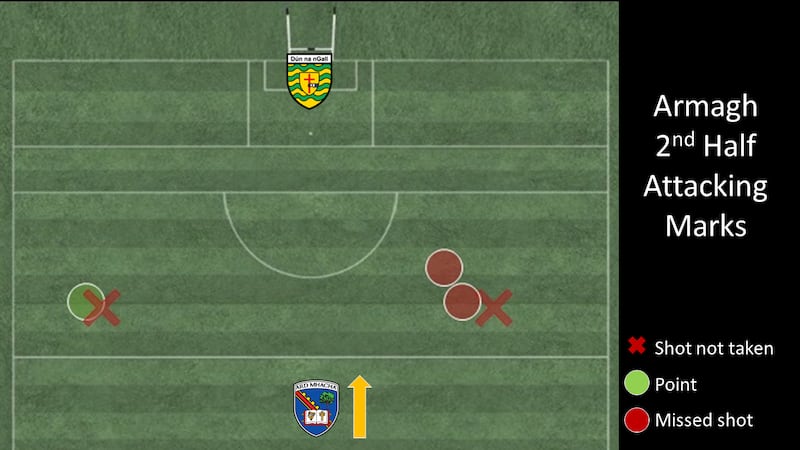
While the quality of shooting on show was impressive at times, the discipline in defending from both teams was extremely impressive as Armagh only conceded three frees inside their 45 over the 90 minutes, while Donegal conceded one solitary scoreable free, cleverly won by Jarly Óg Burns in extra time. This may be indicative of their goal not really being threatened, but considering the volume of bodies in these areas, the attacking quality on show and the tense nature of the game, this level of discipline from both teams was staggering.
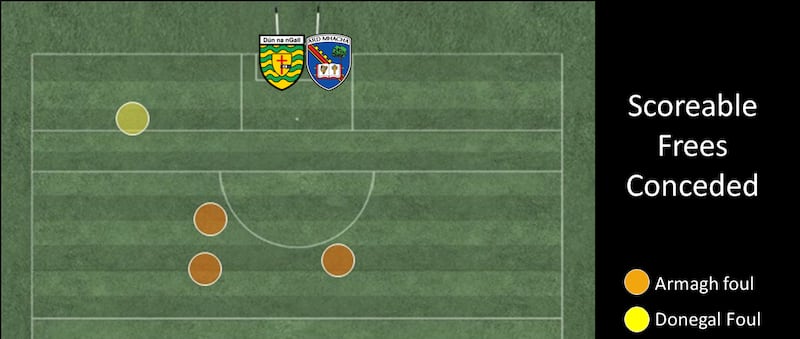
The match day programme expected Brendan McCole to match up with the Conor Turbitt, but he initially matched up with Andrew Murnin. This may have been a mistake by McGuinness as Turbitt started the game full of life and registered 0-3 inside the first 23 minutes before McCole was switched on to him. Surprisingly, the standout man-marking job was done by Oisín Conaty, who gave a huge performance in shutting down the attacking threat of Ryan McHugh, completely negating him. The Kilcar man did not score or assist, while Conaty still contributed at the far end registering 0-2. There is a “but” on this, as Peadar Mogan and Shane O’Donnell were able to punch more holes than usual, increasing their score involvements with the attention paid to McHugh.
Triple threat to triple crown
The contrast of the marquee attacking threats for Galway and Mayo give an insight into the outcome of the Connacht final. Ryan O’Donoghue went into the game in devastating form. Yet, he was turned over twice and missed five shots at the posts from play, only scoring one. A 17 per cent shot conversion rate from play from your star forward will not suffice when margins are so tight. The display of Jack Glynn in marking the Belmullet man was excellent, but it was clearly a Galway defensive ploy to double up on O’Donoghue where possible, and the same with Tommy Conroy.
Conroy was turned over twice, once when one-on-one inside, a duel he would normally relish, and he also missed a shot under pressure. On top of that, Aidan O’Shea’s involvements were kept to a minimum by the tight marking of Sean Fitzgerald before being called ashore after 53 minutes, without registering from play.
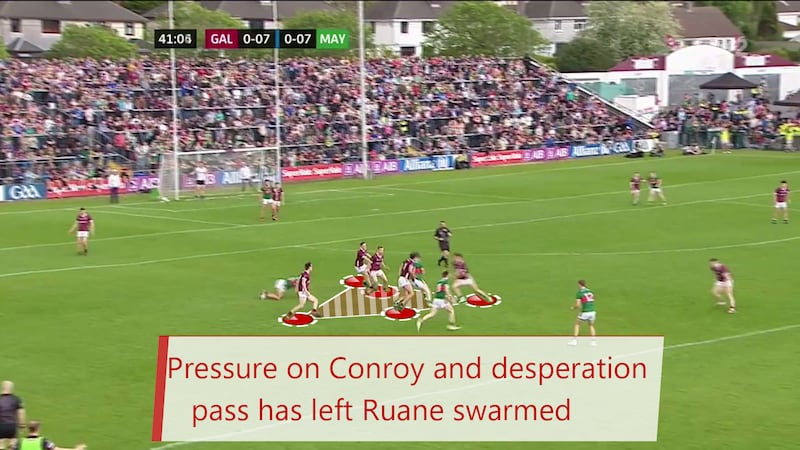
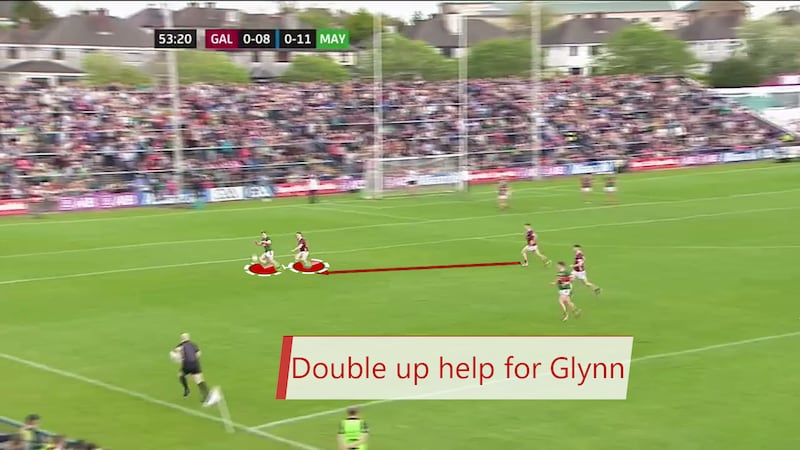
Contrast this with the twin attacking threats of Damien Comer and Rob Finnerty. Between them they had their hand in all Galway’s good play. Comer won four converted frees, had one assist and scored two from play. Finnerty assisted one point, scored five frees and scored another three from play. They were also central to Galway’s two big goal chances, as Finnerty’s exquisite pass opened the Mayo defence, leading to Reape saving expertly from Comer, while Comer’s quick hands inside allowed for Galway’s second-half goal chance through Maher, which Mayo did well to scramble away from the goalline.
One of the key aspects of this in the first half was the structure in which Galway attacked, they did not commit men forward and clog up space. The fact that Mayo approached the game in a man-on-man style meant this left huge spaces for Comer and Finnerty to play in, often in isolated battles.
Then Galway added Shane Walsh into the mix just before half-time and it just adds to the defensive challenges for Mayo. Walsh won a converted free, scored one free himself and added another two from play. All in all, it was the final score of the game from Conor Gleeson before there was a Galway point that did not directly involve this attacking trio.
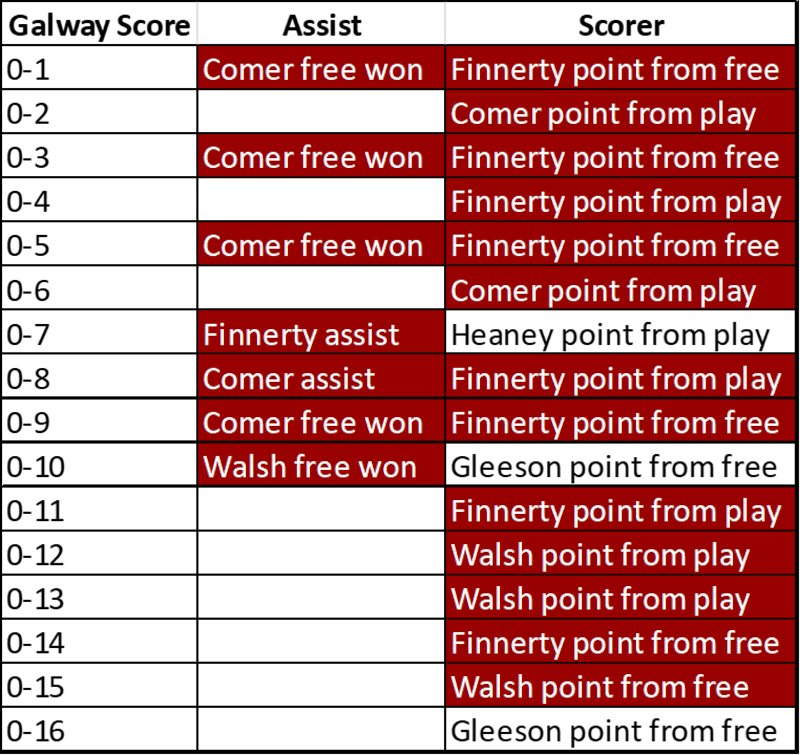
The margins between being a hero and villain are so fine. The Galway goalkeeper Conor Gleeson left Pearse Stadium a hero, but things could have been vastly different had Mayo capitalised before the game came to the clutch stages. In the opening quarter Mayo managed to win two short Galway kickouts inside the 45 but they did not register a score from either, with the goal at their mercy. This was in a period when Mayo were on top and could have turned the screw. Later, a middle third turnover on Gleeson in the 44th minute finished with a Matthew Ruane point, with a quick Galway defensive reset on the turnover removing any threat of goal. Fine margins.
Paul O’Brien is a performance analyst with The Performance Process (twitter.com/NoPlanBGAA).















